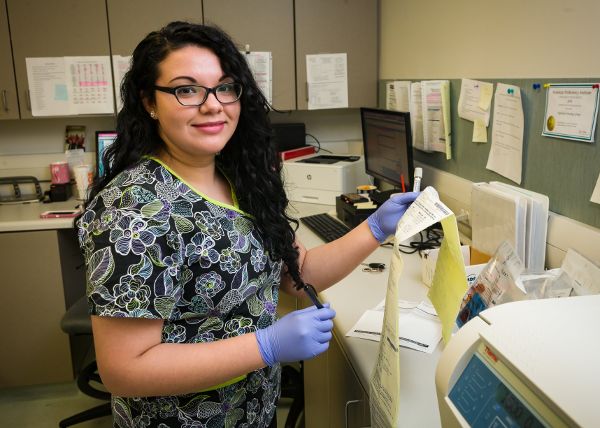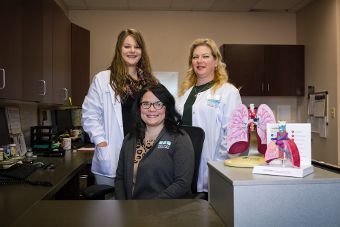Diagnostic Imaging | Ultrasound
Your physician has referred you for an ultrasound scan, a diagnostic procedure designed to reveal important information for use by your physician. He or she will be happy to tell you as much as you’d like to know about this important diagnostic scan.
What is an Ultrasound?
Ultrasound imaging, also called sonography, involves exposing part of the body to high-frequency sound wave to produce pictures of the inside of the body. Ultrasound exams do not use ionizing radiation (X-ray). Ultrasound images are captured in real-time, therefore they can show the structure and movement of the body’s internal organs, as well as blood flowing through blood vessels. Most ultrasound examinations are painless, quick and easy. A registered diagnostic medical sonographer will position you on the table, apply warm gel on your skin (over the area being imaged), and will then press on the skin with a hand-held transducer to obtain the necessary images.
The images are then analyzed and interpreted by a board certified radiologist or cardiologist. The radiologist/ cardiologist will send a signed report to your referring physician, who will then share the results with you. Highlands Oncology uses ultrasound imaging systems that are up to date and provide useful information for your medical diagnosis. Ultrasound is also used to guide needle placement for special procedures.
Preparing for your exam
If your particular exam requires preparation the imaging scheduler will give you those at the time of scheduling. It is important you follow the preparation guidelines so the
sonographer can obtain the best possible images.
Echocardiograms
Transthoracic echocardiogram (or echo) is an ultrasound of your heart. The doctor may order this to evaluate or monitor your heart during chemotherapy, or if you are having symptoms he/she feels could be related to your heart. The sonographer spreads gel on your chest and then presses a device known as a transducer against your skin, aiming an ultrasound beam through your chest to your heart. The transducer records the sound wave echoes your heart produces. A computer converts the echoes into moving images on a monitor.
During the echocardiogram, the sonographer will dim the lights to better view the image on the monitor. You may hear a pulsing “whoosh,” which is the machine recording the blood flowing through your heart. Most echocardiograms take less than an hour, but the timing may vary depending on your condition. During a transthoracic echocardiogram, you may be asked to
breathe in a certain way or to roll onto your left side. No preparation is required for this exam.
Small Parts/Soft Tissue Examinations
Thyroid Ultrasound
A physician may use an ultrasound examination of the neck to help diagnose a lump in the thyroid or a thyroid that is not functioning properly. No preparation is required for this exam.
Scrotal Ultrasound
Ultrasound imaging of the scrotum is the primary imaging method used to evaluate disorders of the testicles and surrounding areas. It is used when a patient is experiencing pain or swelling in the scrotum, a mass has been felt by the patient or doctor, or there’s been a trauma to the scrotal area. Some of the problems ultrasound imaging can identify include: inflammation of
the scrotum, an absent or undescended testicle, testicular torsion, abnormal blood vessels, or a lump or tumor. No preparation is required for this exam.
Vascular Examinations
Vascular ultrasound is the general term for imaging blood vessels including arteries and veins. Lower and upper extremity venous ultrasound is typically performed if a clot in the vein (deep venous thrombosis or DVT) is suspected. The veins in the legs or arms are compressed and the blood flow is assessed to make sure the vein is not clogged. No special preparation is required for
upper or lower extremity ultrasounds.
Abdominal Examinations
Abdominal ultrasound exams may be ordered for a patient with abdominal pain, abnormal laboratory tests, follow up to other types of imaging tests, or a variety of other symptoms and indications.
Patient Preparation
Patient must go without food and drink for eight hours prior to an abdominal study. This is so the sonographer can see the appropriate structures for complete evaluation. Necessary medications may be taken with a small amount of water only.
Gynecological Examinations
Transabdominal Pelvic Ultrasound
High-resolution diagnostic ultrasound assists the physician in the evaluation of the following structures:
- Uterus
- Ovaries
- Other related anatomy
Endovaginal Pelvic Ultrasound
The endovaginal transducer allows close evaluation of the uterus, ovaries and cervix. This technology provides a clear image of the reproductive organs because it is only inches away. This is beneficial especially if there is intestinal contents, such as gas, causing an obstructed view.
Patient Preparation
Patients must have a full bladder before the pelvic exam can be performed. Patients should finish drinking 36 ounces of water one hour before their appointment time. Patients should not empty their bladder once they have started drinking.







